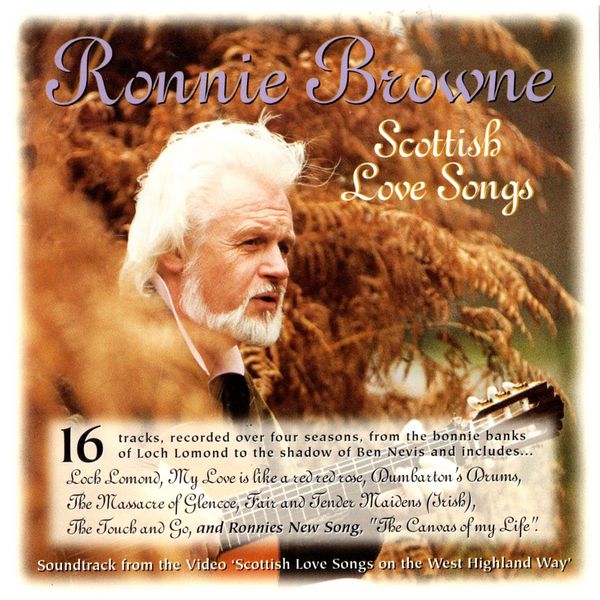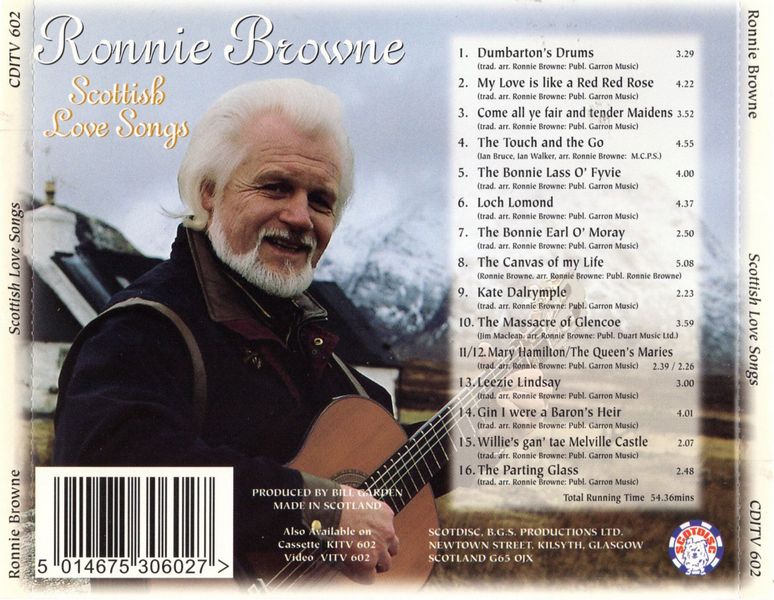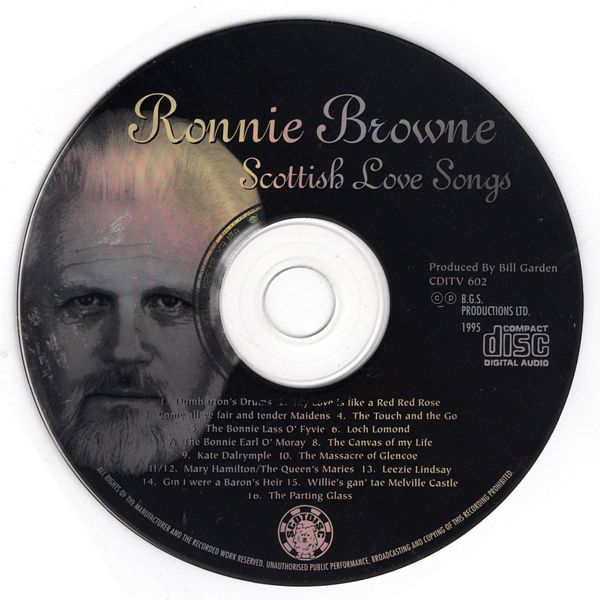
 |

|

|


|
Sleeve Notes
A Song of Love
In presenting this collection of love-songs I am well aware that they are not all strictly so. The Massacre of Glencoe and The Parting Glass have, however, been generally accepted into this genre and The Queen's Maries was written as a direct result of the illicit love affair explained in the poem Mary Hamilton.
Scotdisc very kindly allowed me to film the songs on video and, sitting there serenading my fair and tender maidens in the spectacular Glen Nevis, feeling the brooding atmosphere of the The Queen's Maries in Glencoe, painting The Canvas of my Life on the romantic, oh, so bonnie banks of Loch Lomond, was all an added bonus.
My romantic background as explained in the sleeve-notes of my new song The Canvas of my Life, you will agree, makes me well qualified to sing about love and devotion, and, whilst that specific song was written for Pat, I feel sure none of you will object to my dedicating this whole album to her. I know that she will accept it into such gentle hands.
Kate Dalrymple — If my memory serves me correctly, I seem to remember as a boy. before the days of television in every home, listening each Saturday night at 5.30 to a programme on steam radio called Scottish Country Dancing. The signature tune was 'Kate Dalrymple'. In those days. I only ever heard the melody, so it was with a great deal of pleasure that, when my life led me into singing, I discovered the words of the song. I was particularly pleased to learn from them that.
a. not all lovesongs are of the doom and gloom and sadness variety, and
b. there's hope for us all.
Mary Hamilton/The Queen's Mary — The opening verse of the song poses the question, who was the 'me', the Queen's fourth Mary? When you investigate this question, confusion in the Queen's four Maries' names arises. Seton, Beaton, Fleming, Livingston, Carmichael and Hamilton are mentioned, the Mary Hamilton even having a connection with the history of the Russian Court. There is also the hint of the involvement of an apothecary as being the father of Mary Hamilton's child, instead of the king, which might explain the reference in the poem to 'the Abbey Tree' as being the source of some herb to be used in getting rid of the unwanted child. Other sources will suggest that both Mary Hamilton and Mary Carmichael are pure fiction.
Loch Lomond — There is a Highland superstition which says that, when a warrior falls in battle his spirit will return to the Highlands under the earth, i.e. by The Low Road. Living survivors will obviously return home overland, i.e. The High Road. The Low Road is considered to be the quicker of the two. This version of the song is based on that of a broadsheet which was circulating the streets of Edinburgh in the late 19th century, and concerns two Jacobite prisoners held in Carlisle jail after the '45 Rebellion. The first verse is sung by the narrator of the song, the next three by a sweetheart waiting hopefully at home in the Highlands, and the final verse by one of the prisoners, condemned to death, speaking to his pardoned companion who is about to embark on his way home.
Dumbarton's Drums — This song does not relate to the drums of the garrison of Dumbarton on the Clyde, as many suppose, hut to a British Regiment which was called Dumbarton's Regiment' after its first Commander. The Earl of Dumbarton, who was attached to the Stuart family and died in exile in France in 1692. Any sticklers for detail out there can blame me for changing 'Johnnie' to 'Jeannie'. thereby immediately turning a woman's song into a man's. Sorry ladies.
Lezzie Lindsay — There are many versions of this song and this one is a combination of some of them. I am privileged to have been associated to a certain degree with our National Scottish Rugby Squad. It is no secret how much they like to sing The Flower of Scotland, and I was delighted to learn in speaking with Seán Lineen, that Leezie Lindsay is a particular favourite of his.
The Bonnie Lass O' Fyvie — This song is old enough to have been taken to America by Scottish immigrants in Colonial times. It has been found, mainly in the Southern American States, with the title changed to The Bonnie Lass of Ivory'. The captain's name is altered to 'Wade', and he dies in Louisiana instead of Fyvie. Bob Dylan has recorded a version of it as 'Pretty Polly O', and here in Britain, Martin Carthy has it as Handsome Polly-O'.
Gin I Were A Baron's Heir — I can find no background information on this song whatsoever, except that it is sometimes known as Lassie wad ye lo'e me'. The song will therefore have to speak for itself.
The Massacre Of Glencoe — The confusing religious/political reign of James VII of Scotland, James II of England, caused the crown of England to be offered to and accepted by William of Orange in January of 1689. On May 11th of the same year, he also accepted the crown of Scotland. Unrest carried on, however, amongst the Highland clans, many still loyal to James. Eventually. William proclaimed that it they did not take an oath of allegiance by January 1st, 1692, they would be treated as outlaws, and their lands made forfeit to the Crown. Alexander Macdonald, of the Glencoe Macdonalds, because of snowstorms, took the oath late on January 6th. Sir John Dalrymple, the Secretary of State for Scotland wanted to subdue the Highland clans forever and William was not told of this late signature but was persuaded to issue letters of Fire and Sword' against the Macdonalds, making an example of them. Later that month a troop of 120 soldiers, mostly Campbells, deadly enemies of The Macdonalds, accepted their unsuspecting hospitality and proceeded to perpetrate the Infamous Massacre of Glencoe.
Willie's Gan' Tae Melville Castle — A simple tale of a young man evidently extremely popular with the ladies. The unknown writer would no doubt be Interested to note how prophetic his closing words have turned out to be in the last verse. " … and then I'll wed ye's a'", when you consider that the Melville Castle in question, just outside Edinburgh, is now a Hotel and a favourite venue for weddings.
Come All Ye Fair and Tender Maidens — I hope I'll be forgiven for including this Irish song. I do so for purely nostalgic reasons in as much as, every time I sing it, I'm transported to my early singing days at parties in company with legends such as The Clancy Brothers, Banjo Barney McKenna and the late Luke Kelly, as soloists before the formation of the Dubliners, and the then fresh-faced Fureys, Fin and Eddie, to name but a few. My God, am I getting old?
The Canvas of my Life — In early 1954, whilst at Boroughmuir School in Edinburgh, I met a wee cracker called Pat Elliot. There followed a five year courtship, culminating in our wedding on June 30th, 1959. In all that time. Pat has been by my side, and on my side, well … give or take a few … . in everything I've ever done. It was glancing up at one of the various portraits I've painted of her over the years that set me thinking about writing this song. So this one is for Pat, for a lifetime's love, support and encouragement throughout the good times and the bad. And, by the way, she's still a wee cracker.
The Touch and The Go — When you try to telephone Ian Bruce, he's invariably no' there. He's constantly away somewhere singing mainly his own compositions in America or Germany or some such place. His popularity is not surprising when you hear the quality of songs like this. I am told that the sentiments of the words he's written here are not, happily, based on his own life experience.
The Parting Glass — There's and old Scottish song written by Sir Alex. Boswell called "Goodnight an' joy be wi' ye a'", which has, "time out of mind, been played at the breaking up of convivial parties in Scotland". Although it contains the same sentiments as The Parting Glass, I feel the words are not as relevant to modern gatherings, and I therefore choose this, which I believe to be the Irish equivalent, to put a final close to my own live performances. In making it the final song of this collection I hasten to say that I hope that this is not 'Goodbye', but merely 'Au revoir'. A' the best.
My Love is Like a Red Red Rose — Arguably the best love song ever written, but without question certainly one of the best known. At a recent concert, after the show, a friend of mine who had been in the audience came back stage to compliment me on one of the songs. When I asked which one in particular, he replied. "That one called, 'My Love is Like a Red Red Nose'. I'm awfy glad I had done this recording of it long before because I'll never think of it in the same way again. I hope you've listened to it before you read this note.
The Bonnie Earl O' Moray — James Stewart, 2nd Earl of Moray, known because of his handsome countenance as, 'The Bonnie Earl'. In 1592, King James VI of Scotland ordered Moray's arrest for a misdemeanour. He sent The Earl of Huntly of the Gordon family to arrest Moray knowing full-well that a deadly feud existed between the two families and perhaps suspecting that Huntly would probably have no intention of taking him alive. The ballad states that Moray was "the Queen's true love". If this was so, and the King knew of it, what a convenient way to be rid of him. At any rate The Bonnie Earl was butchered at Donibristle in Fife by The Earl of Huntly and 40 of his Gordons.